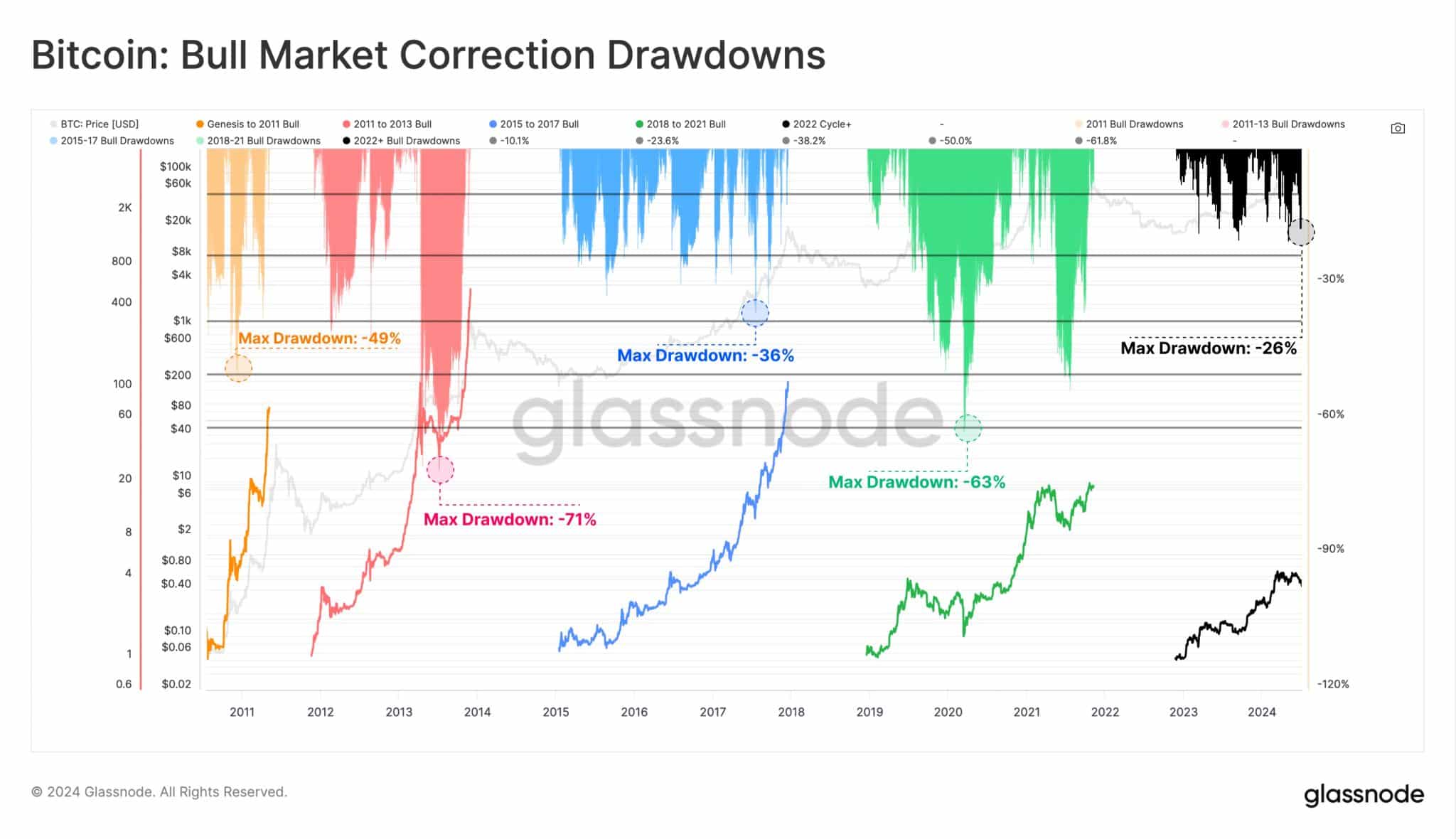Glassnode’s latest report suggests that despite Bitcoin reaching a new all-time high this year, its current cycle is among the worst-performing compared to previous cycles.
Today, the crypto market is experiencing a notable rebound, led by Bitcoin’s rally as it reclaims the $63K range. Altcoins have followed suit, reaching new monthly highs. This development comes just two weeks after Bitcoin had dropped to a low of $53K.
Amid this bullish resurgence, analytics platform Glassnode conducted an in-depth analysis of Bitcoin’s price movements over the past 18 months. It compared the current cycle to previous ones and observed strange similarities.
Bitcoin Replicating History, Though Poorly in Uptrend
According to the report, the market enjoyed a steady 18-month price increase following the FTX collapse. However, after Bitcoin reached a high of $73,750, a three-month period of consolidating prices followed.
During the bearish days between May and July, the Bitcoin market experienced its most significant correction in this bull cycle as it crashed by over 26% from its all-time high.
Meanwhile, Glassnode observed that this downturn has been relatively mild compared to previous cycles. For instance, in the 2020/2021 bull season, Bitcoin dropped 63% before the ultimate rally to the cycle’s peak. In the previous season, Bitcoin also retraced by 36%.
Nonetheless, the analysis revealed that Bitcoin’s price performance shows a striking similarity to previous cycles when measured from each cycle’s low point, echoing patterns seen in 2018-2021 and 2015-2017.

Yet, a closer examination of the data reveals a stark contrast when performance is indexed to the Bitcoin halving date. Surprisingly, the current cycle ranks among the worst-performing despite the market achieving a new all-time high before the April halving event – a milestone never seen before.
Illustratively, three months after the fifth and most recent Bitcoin halving, the asset has declined by 13%. This contrasts with the 30% gain recorded during the same time frame after the fourth halving.
New Investors Underwater
The Glassnode report also highlighted a significant increase in the supply volume held by short-term Bitcoin holders. This surge coincided with the launch of Bitcoin spot ETFs, which triggered a rapid price increase driven by new solid demand.
Specifically, since January 2024, new investors have been buying in, but growth has plateaued in recent months, leading to a supply overhang. As a result, many new investors are now underwater.
Currently, around 2.8 million BTC are held at a loss, similar to August 2023. The present situation has persisted for 20 days, but it is less severe compared to 2021, when a comparable trend lasted for 70 days and eventually contributed to a significant market downturn in 2022.
Overall, the analysis observed that after 18 months of steady growth following the FTX implosion, the market experienced three months of sideways trading before entering its deepest correction of the cycle.
Despite this, the current drawdowns remain relatively mild compared to historical cycles, indicating a robust underlying market structure.
Glassnode’s latest report suggests that despite Bitcoin reaching a new all-time high this year, its current cycle is among the worst-performing compared to previous cycles.
Today, the crypto market is experiencing a notable rebound, led by Bitcoin’s rally as it reclaims the $63K range. Altcoins have followed suit, reaching new monthly highs. This development comes just two weeks after Bitcoin had dropped to a low of $53K.
Amid this bullish resurgence, analytics platform Glassnode conducted an in-depth analysis of Bitcoin’s price movements over the past 18 months. It compared the current cycle to previous ones and observed strange similarities.
Bitcoin Replicating History, Though Poorly in Uptrend
According to the report, the market enjoyed a steady 18-month price increase following the FTX collapse. However, after Bitcoin reached a high of $73,750, a three-month period of consolidating prices followed.
During the bearish days between May and July, the Bitcoin market experienced its most significant correction in this bull cycle as it crashed by over 26% from its all-time high.
Meanwhile, Glassnode observed that this downturn has been relatively mild compared to previous cycles. For instance, in the 2020/2021 bull season, Bitcoin dropped 63% before the ultimate rally to the cycle’s peak. In the previous season, Bitcoin also retraced by 36%.
Nonetheless, the analysis revealed that Bitcoin’s price performance shows a striking similarity to previous cycles when measured from each cycle’s low point, echoing patterns seen in 2018-2021 and 2015-2017.

Yet, a closer examination of the data reveals a stark contrast when performance is indexed to the Bitcoin halving date. Surprisingly, the current cycle ranks among the worst-performing despite the market achieving a new all-time high before the April halving event – a milestone never seen before.
Illustratively, three months after the fifth and most recent Bitcoin halving, the asset has declined by 13%. This contrasts with the 30% gain recorded during the same time frame after the fourth halving.
New Investors Underwater
The Glassnode report also highlighted a significant increase in the supply volume held by short-term Bitcoin holders. This surge coincided with the launch of Bitcoin spot ETFs, which triggered a rapid price increase driven by new solid demand.
Specifically, since January 2024, new investors have been buying in, but growth has plateaued in recent months, leading to a supply overhang. As a result, many new investors are now underwater.
Currently, around 2.8 million BTC are held at a loss, similar to August 2023. The present situation has persisted for 20 days, but it is less severe compared to 2021, when a comparable trend lasted for 70 days and eventually contributed to a significant market downturn in 2022.
Overall, the analysis observed that after 18 months of steady growth following the FTX implosion, the market experienced three months of sideways trading before entering its deepest correction of the cycle.
Despite this, the current drawdowns remain relatively mild compared to historical cycles, indicating a robust underlying market structure.





